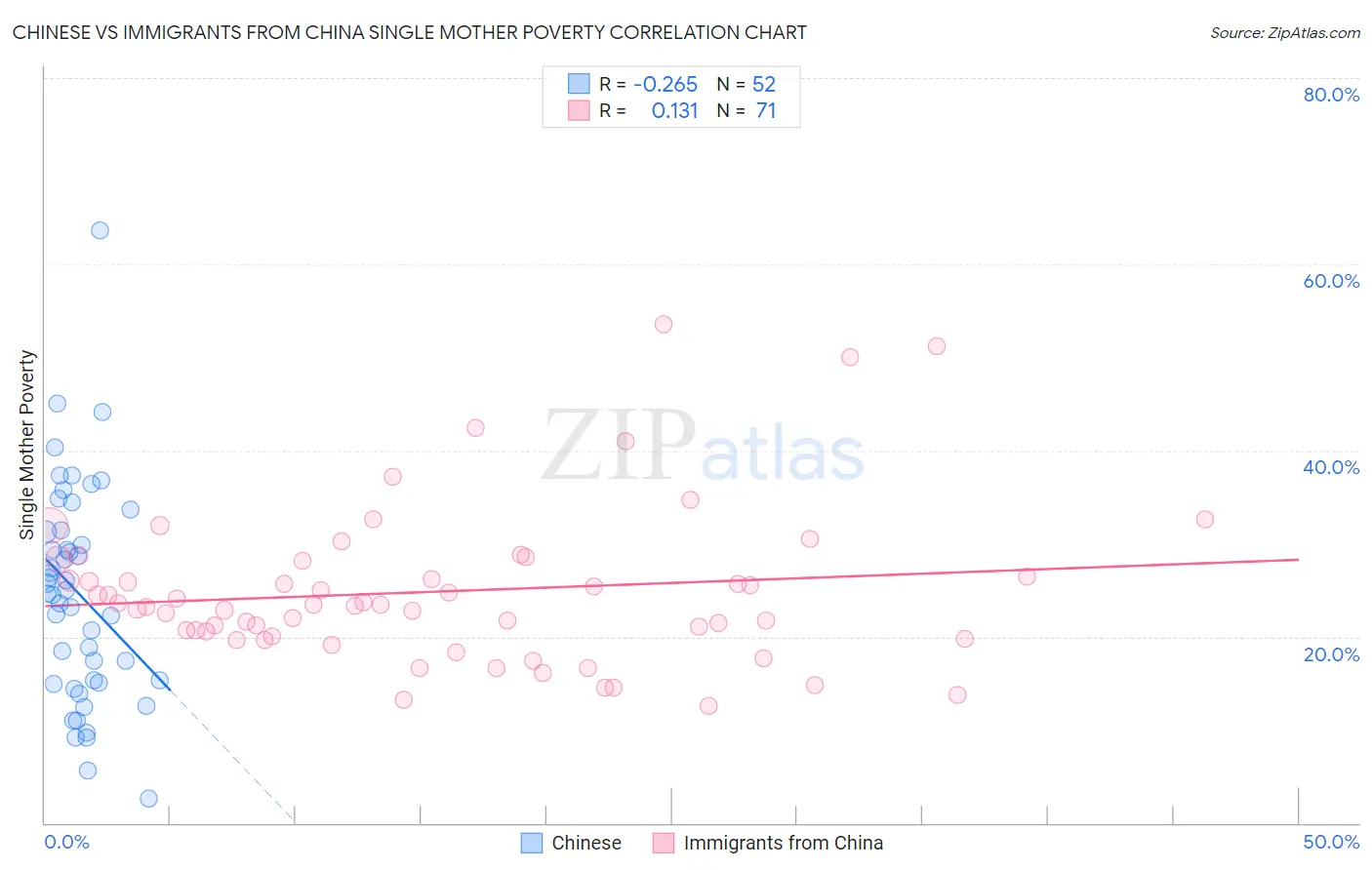Chinese vs Immigrants from China Single Mother Poverty
COMPARE
Chinese
Immigrants from China
Single Mother Poverty
Single Mother Poverty Comparison
Chinese
Immigrants from China
24.6%
SINGLE MOTHER POVERTY
100.0/ 100
METRIC RATING
7th/ 347
METRIC RANK
26.1%
SINGLE MOTHER POVERTY
100.0/ 100
METRIC RATING
20th/ 347
METRIC RANK
Chinese vs Immigrants from China Single Mother Poverty Correlation Chart
The statistical analysis conducted on geographies consisting of 64,411,570 people shows a weak negative correlation between the proportion of Chinese and poverty level among single mothers in the United States with a correlation coefficient (R) of -0.265 and weighted average of 24.6%. Similarly, the statistical analysis conducted on geographies consisting of 441,985,494 people shows a poor positive correlation between the proportion of Immigrants from China and poverty level among single mothers in the United States with a correlation coefficient (R) of 0.131 and weighted average of 26.1%, a difference of 6.0%.

Single Mother Poverty Correlation Summary
| Measurement | Chinese | Immigrants from China |
| Minimum | 2.6% | 12.6% |
| Maximum | 63.6% | 53.5% |
| Range | 61.1% | 41.0% |
| Mean | 24.6% | 24.9% |
| Median | 24.8% | 23.4% |
| Interquartile 25% (IQ1) | 15.2% | 20.0% |
| Interquartile 75% (IQ3) | 31.4% | 28.2% |
| Interquartile Range (IQR) | 16.2% | 8.2% |
| Standard Deviation (Sample) | 11.6% | 8.3% |
| Standard Deviation (Population) | 11.4% | 8.2% |
Demographics Similar to Chinese and Immigrants from China by Single Mother Poverty
In terms of single mother poverty, the demographic groups most similar to Chinese are Thai (24.5%, a difference of 0.54%), Immigrants from Hong Kong (24.4%, a difference of 1.0%), Filipino (24.3%, a difference of 1.3%), Immigrants from Iran (25.1%, a difference of 2.0%), and Immigrants from Lithuania (25.2%, a difference of 2.4%). Similarly, the demographic groups most similar to Immigrants from China are Immigrants from Eastern Asia (26.1%, a difference of 0.13%), Immigrants from Bolivia (26.2%, a difference of 0.19%), Immigrants from Pakistan (26.0%, a difference of 0.27%), Immigrants from Korea (26.2%, a difference of 0.36%), and Burmese (26.2%, a difference of 0.54%).
| Demographics | Rating | Rank | Single Mother Poverty |
| Immigrants | Taiwan | 100.0 /100 | #3 | Exceptional 23.9% |
| Filipinos | 100.0 /100 | #4 | Exceptional 24.3% |
| Immigrants | Hong Kong | 100.0 /100 | #5 | Exceptional 24.4% |
| Thais | 100.0 /100 | #6 | Exceptional 24.5% |
| Chinese | 100.0 /100 | #7 | Exceptional 24.6% |
| Immigrants | Iran | 100.0 /100 | #8 | Exceptional 25.1% |
| Immigrants | Lithuania | 100.0 /100 | #9 | Exceptional 25.2% |
| Immigrants | South Central Asia | 100.0 /100 | #10 | Exceptional 25.3% |
| Iranians | 100.0 /100 | #11 | Exceptional 25.5% |
| Bhutanese | 100.0 /100 | #12 | Exceptional 25.6% |
| Indians (Asian) | 100.0 /100 | #13 | Exceptional 25.8% |
| Immigrants | Singapore | 100.0 /100 | #14 | Exceptional 25.8% |
| Immigrants | Ireland | 100.0 /100 | #15 | Exceptional 25.8% |
| Bolivians | 100.0 /100 | #16 | Exceptional 25.9% |
| Asians | 100.0 /100 | #17 | Exceptional 26.0% |
| Immigrants | Pakistan | 100.0 /100 | #18 | Exceptional 26.0% |
| Immigrants | Eastern Asia | 100.0 /100 | #19 | Exceptional 26.1% |
| Immigrants | China | 100.0 /100 | #20 | Exceptional 26.1% |
| Immigrants | Bolivia | 100.0 /100 | #21 | Exceptional 26.2% |
| Immigrants | Korea | 100.0 /100 | #22 | Exceptional 26.2% |
| Burmese | 100.0 /100 | #23 | Exceptional 26.2% |